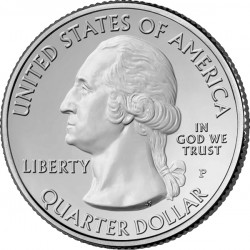
The fourth strike to appear in 2013 as part of the US Mint’s America the Beautiful Silver Bullion Coin™ Program will be the 2013 Fort McHenry America the Beautiful Silver Bullion Coin. This coin also marks the nineteenth strike in the series which launched in 2010 and runs through 2021 with a total of 56 new issues.
All of the coins in the program will be struck from five ounces of .999 fine silver to a massive diameter of three inches. As the coins weight and purity are guaranteed by the government of the United States, the weight and purity of each piece will be inscribed on the edge.
These silver bullion coins were authorized as part of the America’s Beautiful National Parks Quarter Dollar Coin Act of 2008. The main purpose of this act was to create circulating quarter dollars that contained designs depicting beautiful locations throughout the United States. The silver bullion coins will feature the same designs as found on the quarter dollars.
The obverse of each bullion strike (as well as the quarter dollars) will show a portrait of the first President of the United States, George Washington. He has been featured on the quarter dollar since 1932, so it is no surprise that his portrait will be seen on these coins.
As this particular coin was created to honor Fort McHenry National Monument and Historic Shrine in Maryland, it will be a portion of that area which will be featured on the reverse of the coin. The final design should be unveiled in early 2013 along with the designs for the other 2013 America the Beautiful coins. Design candidates will probably be released early in the previous year to allow time for their review by the appropriate groups and individuals.
A total of 56 new strikes will be created under this program with each one honoring a different site of national interest. These sites could be a national park, national monument, national forest, etc. Aside from their federal status, the Act authorizing them also dictates that only one site is to be chosen from each state, the District of Columbia and the five US territories – Guam, US Virgin Islands, Puerto Rico, American Samoa and the Northern Mariana Islands.
When each bullion coin is released, only a network of authorized purchasers will be allowed to purchase them directly from the US Mint. They, in turn, will then resell them to coin dealers and individuals for a small mark-up over the spot price of the silver contained within them.
Three America the Beautiful Bullion Coins will precede the Fort McHenry strike in 2013. They will include coins honoring White Mountain National Forest of New Hampshire, Perry’s Victory and International Peace Memorial in Ohio and Great Basin National Park in Nevada. One will follow the McHenry piece and it will honor Mount Rushmore National Memorial in South Dakota.
Fort McHenry National Monument and Historic Shrine in Maryland
Located on the Locust Point Peninsula of the Baltimore Harbor in Baltimore, Maryland is the Fort McHenry National Monument and Historic Shrine.
This historic site is the location of many important events throughout its existence, but none probably more so important that the role it played during the War of 1812. Realizing the importance of the harbor and the city, Fort McHenry was built to defend them in the years after the American Revolution. Within a few decades of its construction, it was called upon to do just that.
During the height of the War of 1812, which pitted American forces against those of Great Britain, British warships were poised on the entrance to the Baltimore Harbor. The only thing preventing them from entering and taking control was a few sunken blockades and the defenses of Fort McHenry. For 25 hours beginning on the morning of September 13, 1814, the British ships assaulted Fort McHenry with cannon and rockets. Owing mostly to the poor accuracy of these devices, Fort McHenry survived and very few casualties were reported. Unable to break the defenses, the British ships retired.
It was while onboard a truce ship that Francis Scott Key witnessed the bombardment of the fort and it was this that provoked him to write the poem that would one day become the national anthem of the United States – "The Star-Spangled Banner."
The Fort has served several other purposes since the War of 1812 including a military prison during the American Civil War, a hospital during World War I and a Coast Guard base. In 1925, the Fort was named a national park only to be re-designated a national monument and historic shrine in 1939.